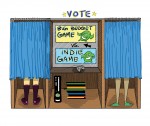The word “independent” is quickly becoming ubiquitous in internet publishing.
The massive network that connects almost everyone in the world has afforded independent game developers the tools to bypass the big publishing companies and bring their product straight to the consumer.
The thing that’s so great about online marketplaces is that they’re essentially creating a community. Consumers are now involved in every step of the developing process, which allows for a dialogue between player and developer that could potentially lead to a revolutionized model of game distribution.
In an industry that’s full of big budget sequels, movie tie-ins and other safe bets, there is not a lot of room left for game developers who are creating products that are sometimes revolutionary, but done on a much smaller scale and don’t always fit the model for a commercial game.
That’s where companies like Kickstarter come in, which enable indie developers to find funding and an audience before they even begin working on a game.
A great example is the game “Wasteland 2.” In 1988, “Wasteland” was released by Electronic Arts. It was a cult hit but not a huge moneymaker.
Brian Fargo, executive producer of the original game, retained the rights and decided to use Kickstarter to hopefully bring “Wasteland 2” to life. He asked for $900,000 – what he got was $2,933,252. People obviously wanted the game, and the support was huge.
A lot of indie game developing companies have skeleton crews of only a few people. They do the art and coding for the game and then release the product on online marketplaces like Steam, PlayStation Network, Xbox LIVE and mobile marketplaces, like the Apple App Store.
Online fundraising allows indie game developers to feel out the market despite not having the resources that big publishing companies have.
Indie developers have the opportunity to study their target audience by posting on and monitoring online gaming message boards, or giving copies of their game-in-progress to game bloggers in the hopes of generating interest.
But some games will never get the recognition they deserve. It may have amazing graphics, a stellar story and totally creative game play – but never get off the ground.
It’s the luck of the draw and the main reason having a publisher is so advantageous to developers. Publishers do the leg work, make sure everyone knows the game is out, host giveaways, conduct interviews, etc.
The developers of the game “Crabitron” spent approximately $100,000 to build their game without a publishing company, and have so far only made about $11,000 back.
They’re hoping that word of mouth will invigorate the game, but who knows? The free market is a strange and fickle thing. That’s one of the reasons game publishers will spend millions on advertising – it’s pretty much half the battle.
But with the advent of this free market economics model, a whole clutch of new games are able to make it to consumers, when before there was really no centralized way to bring a product directly to the masses.
And not only are there a multitude of games out there, the price point is much smaller than the $60 spent on console games, allowing consumers to buy more games and, in turn, energizing the gaming industry as a whole.
It’s possibly the best thing to happen to games since someone decided to put Mario and Donkey Kong on little go-karts and make them race.
What would you create if you had the cash? Email agilvezan@media.ucla.edu.
